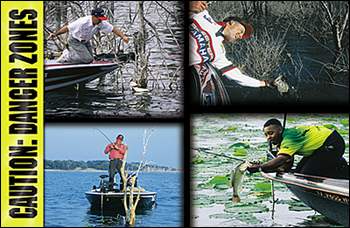
Landing the tough ones isn't as tough a proposition as you might think provided you understand and employ a few basic principles.
By Paul A. Cañada
Page 2
Big Fish + Tough Cover = Big Problems
Like Duplechain, nationally renown angler Dennis Canada has been guiding on Lake Fork for years. Throughout those years he has seen many double-digit bass successfully taken from the timber- and grass-filled waters of Lake Fork. According to Canada, after hooking a lunker in cover
the very first thing an angler must do is keep the bass moving up and out.
Anglers have a choice: either battle the bass in the thick cover or on the water surface. Canada prefers the latter. Because of this, he believes it's very important to gain control of the fish immediately after the hook set. In doing so, the angler can successfully take the battle to the water surface and away from the thick cover.
Admittedly, a big bass goes where a big bass wants. The angler who places too much pressure on a Lake Fork giant risks tearing the hook free or straightening it out. Often, a pressured bass moves deeper into the cover, making it tougher although not impossible to land.
"I tell my clients when the bass buries up in the cover, you have got to let up on the pressure," explains Canada. "The harder you pull, the deeper the fish buries itself. When the bass is in the cover, you simply have to go in and get it."
When the bass successfully buries up in the grass, Canada says he applies just enough pressure to keep his rod loaded. The light pressure holds the bass up against the grass, where it eventually tires from the extra weight of the cover. According to Canada, the worst thing that can happen is for an angler to get into a tug-of-war with a big bass. A trophy-sized bass that is pulled too tight against the cover has the leverage it needs to tear the hook free.
Canada uses this same technique when wrestling bass from timber. "When I feel I have lost control and fear the fish might wrap around the timber, I immediately back off the pressure," he notes. "Ninety percent of the time, when you let up on that pressure, the bass comes back out. Again, sometimes you have to go in and get it."
Those Darn Itty-Bitty Treble Hooks
As David and I discovered on Richland-Chambers Reservoir, one of the toughest fish to successfully land is a big trophy hooked on a comparably small treble hook. B.A.S.S. pro Mike Auten finds one of the most important keys to landing crankbait fish is the equipment with which the angler chooses to fish.
"When it comes to landing big fish," Auten tells us, "the most important piece of equipment is your rod. When crankin', you want to use a rod that's more forgiving and slower to react."
Many professionals consider fiberglass to be a much better rod material for fishing crankbaits, simply because it's a slower-recovering material. Unlike fiberglass, the faster graphite tends to snap back from a strike or surge tearing the hook free from the bass' mouth. Of course, a soft rod is of little use when the angler's line is junk.
Like Duplechain, Auten pays close attention to the condition of his line. "I am constantly checking my line for abrasions and retying my knots," he explains. "The shock created by the long casts normally associated with fishing crankbaits places a lot of stress on the line."
After hooking a fish, Auten uses his trolling motor to work it away from the cover and then "parks" the fish out away from the boat. Anglers horsing a fresh fish to the boat greatly increase the risk of losing it. By parking the bass out away from the boat, Auten allows it to fight and eventually fatigue itself. Often, the combination of a thrashing, head-shaking bass, a forgiving rod and sharp hooks results in both sets of treble hooks finding flesh.
When Auten is ready to bring the bass to the boat, he's careful to use his rod to direct the fish. The Skeeter pro recommends anglers walk the fish around the boat until it's ready to be netted. Changing the angle of pressure (such as with the figure-8 technique) tends to open the hook wound, making it easier for the fish to throw the bait.
Whether fishing a crankbait, spinnerbait or a jig, one of the biggest mistakes anglers make is constantly changing the angle of the rod. Auten adds, "Big bass will often inhale a bait. So every time you swing that rod back and forth, you're raking the line across the bass' teeth. Eventually, " he cautions, "the line will break."
By practicing the techniques and tips of the pros, anglers stand a better chance of landing that trophy of a lifetime. Auten sums it up nicely by saying, "Above all else, it's important not to get too excited. You have the fish hooked, and so have time to work. Remember, most fish are lost when anglers rush, making either the wrong decision or the wrong move."
# # # #
page 1 / page 2
| 




